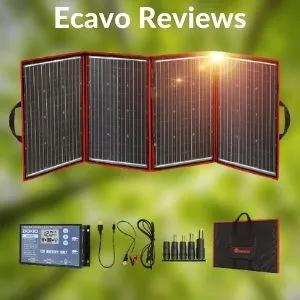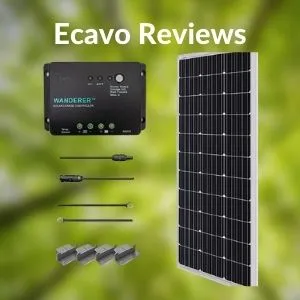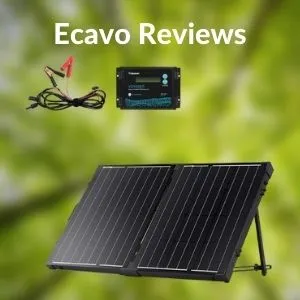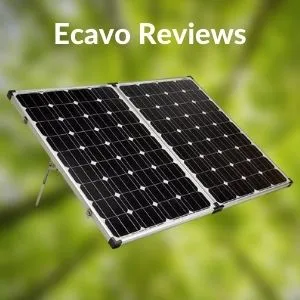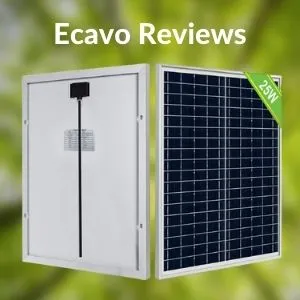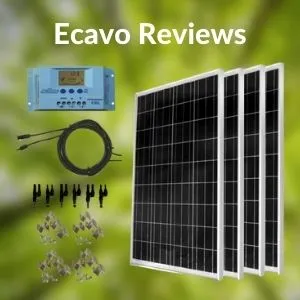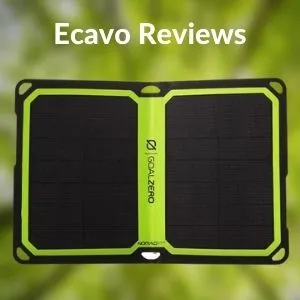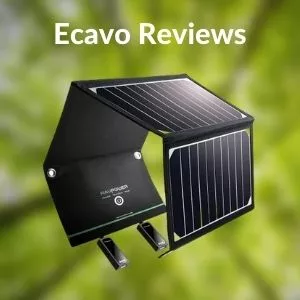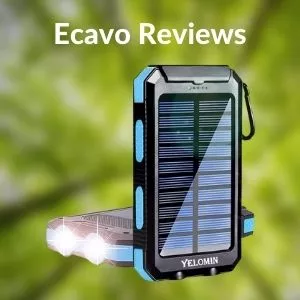If you want a power supply in an area where no plugs are the norm, you want the security of knowing you can charge your cell phones or keep your food cold. In the olden days, this meant buying a gas-powered generator and conserving fuel, just in case. The great news today is that you have renewal, plentiful power sources to rely on instead.
You can take charging with you! Solar panels that charge from that ever-present resource, the sun, no longer need to be huge arrays permanently mounted on your roof with a garage full of batteries. You can now choose from among the best portable solar panels around to design and deploy a charging station no matter where you are.
We compare the best solar panels with portability and flexibility in mind in this article. Our selections include power sources appropriate for cell phones, laptops, and appliances. These can be great for your emergency kit, for your off-the-grid household, or for use on pleasure trips and camping adventures.
Table of Contents
- Best Portable Solar Panels
- What to Know about Portable Solar Panels
- How do portable solar panels work?
- What kind of sun exposure does a solar panel require?
- Is a battery needed with portable solar panels?
- How do monocrystalline and polycrystalline compare?
- What is the difference between styles of portable solar panels?
- When are portable solar panels better than gas generators?
- When is a permanent solar panel installation better than portable?
- What limitations do portable solar panels have?
- FAQs about Portable Solar Panels
- Selection Criteria for Portable Solar Panels
Best Portable Solar Panels
- Best for Multipurpose: DOKIO 220 Watts 12 VoltsÂ
- Most Popular: Jackery SolarSaga 100W Portable Solar Panel
- Best for Expandability: Renogy 100 Watts 12 Volts Solar Starter Kit
- Best for Snow Loads: Renogy 160W 12V Monocrystalline Off Grid
- Best for RV or Trailer: Zamp Solar 120P Charge Kit
- Best for On-the-Water: ECO-WORTHY 25 Watt 12 Volt Off Grid
- Best for Remote Settings: WindyNation 400 Watt Solar Kit
- Best for Curved Applications: Renogy 175 Watt 12 Volt Flexible
- Best for Power + Portability: Goal Zero Nomad 7 Plus
- Best for Light-to-Carry: RAVPower Solar Charger 16W
- Best for Low Budgets: Yelomin 20000mAh
Best for Multipurpose: DOKIO 220 Watts 12 Volts
Panel style: Foldable
Wattage output: 220W
What it runs: 12V or 24V battery
Storage size: 22†x 29†x 1â€
Surface area: 40†x 27â€
Weight: 10.6 lbs.
Durability: A
If your needs are complex but you want a straightforward power solution, this DOKIO could be for you. It generates a lot of power for its size, enough wattage to jumpstart your truck battery or emergency equipment. It is easy to fold into 4 and put in the back of your vehicle for unexpected situations where a jolt of juice is required.
The panels fold in 4 for storage in the provided case, which comes in handy when trying to protect it on the move.. Panels are hinged and can be folded into 4 to take advantage of best sun exposure. High-efficiency silicon makes the most of bright days and works well on cloudy days too.
The 10-foot cable connects easily to both 12- and 24-volt batteries, which means it can be used for non-vehicle batteries too.
The included charge controller has two USB ports for direct connect to USB-corded devices. If you want an easy system to set up and a lightweight package to carry, this DOKIO can meet an array of your powering-up needs.
See Price on AmazonMost Popular: Jackery SolarSaga 100W Portable Solar Panel
Panel style: Foldable
What it runs: 18V battery.
Storage size: 47†x 22†x 2â€
Surface area: 43†x 20â€
Wattage output: 100W
Weight: 16.5 lbs.
Durability: A
If you want a portable system with USB outputs this Jackery panel is the thing for you. The kit includes a carrying bag on the back.
Built with efficiency in mind, this panel reports to produce 23% more energy in hot weather.
See Price on AmazonBest for Expandability: Renogy 100 Watts 12 Volts Solar Starter Kit
Panel style: Fixed
What it runs: 12V battery
Storage size: 47†x 22†x 2â€
Surface area: 43†x 20â€
Wattage output: 100W
Weight: 16.5 lbs.
Durability: A
If you want a portable system you can add on to as your needs grow, this Renogy gives you a terrific base to begin. The starter kit includes a charge controller, ground rod, and 8-foot cables to reach your battery. Brackets allow you to mount the panel if you wish, or it can be deployed on its own at a distance with the 20-foot connector.
Each panel comes with it’s own PWM controller as well.
This panel can provide up to 500W of power over the course of a day under optimum conditions. Hook together up to four panels in total for juice to run everything your campsite or cabin might need. This system can be permanently mounted on any flat surface, ideally at a 30â° angle to capture the most sun exposure.
This panel also comes in a 200W version
Users like to mount this panel on top of RVs for set and forget ease of use, though this does not always produce the maximum charge due to angle and in shady situations. While occasional reports of problems with wiring or the charge controller are noted, the overwhelming positives of this system include its easy installation and great tech support.
If you like boondocking in remote settings or have a cabin deep in the woods, this system can grow into exactly what you need for power.
See Price on AmazonBest for Snow Loads: Renogy 160W 12V Monocrystalline Off Grid
Panel style: Fixed
What it runs: 12V battery
Storage size: 52†x 26†x 2â€
Surface area: 50†x 24â€
Wattage output: 160W
Weight: 25.9 lbs.
Durability: A
Renogy builds their panels to withstand a lot, and in the case of this high-producing model, even snow loads are no match. Note that this system is the panel and connector cables alone; you’ll buy the charge controller separately. It is a great base unit or addition to a system you’d like to grow with the addition of more panels.
This panel is optimized for installation on roofs or on the ground at the appropriate sun exposure angle, and it works well in low-light conditions. The monocrystalline silicon layer is sandwiched between tempered materials that will not degrade in weather extremes. It works equally well in mobile applications when building into your overall portable solar panel system and mounted on an appropriate frame.
Some users have added this panel to other manufacturers’ systems with solid success, though that is not recommended and voids your warranty. Others use it for car or RV camping and create their own mounting system. Once you add the charger of your choice, you too will be ready to capture some awesome wattage from this portable panel.
See Price on AmazonBest for RV or Trailer: Zamp Solar 120P Charge Kit
Panel style: Suitcase
What it runs: 6- or 12-volt battery, or direct SAE port
Storage size: 35†x 22†x 4â€
Surface area: 33†x 40â€
Wattage output: 120W
Weight: 32.0 lbs.
Durability: B
If you want to run your solar power directly into your camper for your small appliances, this could be the portable panel set for you. It folds into a slim-depth suitcase, included with your kit. Users note that it can feel cumbersome because it is so heavy.
Flexibility is one of the things that sell people on the Zamp system. Besides running the power directly into the vehicle, it can charge a 6- or 12-volt battery for round-the-clock use. Direct sun for prolonged periods works best for full battery charges.
The durability on the panels themselves appears to be good. Some complaints about the clips to fasten the unit when closed have been reported. If you want a system you can deploy in 5 minutes and use to charge in several ways, the Zamp suitcase could be for you.
See Price on AmazonBest for On-the-Water: ECO-WORTHY 25 Watt 12 Volt Off Grid
Panel style: Foldable
What it runs: 12V battery
Storage size: 16.5″ x 12.6″ x 0.67″
Surface area: 20†x 28â€
Wattage output: 25W
Weight: 11.33 lbs.
Durability: A
This ECO-WORTHY unit wins high praise for its durability under otherwise punishing conditions, like not corroding in saltwater or deteriorating due to heavy weather. The charge controller is already installed, eliminating a step for your setup. It ranks highly for overall ease of use and its light and manageable weight.
This set of solar panels can power other remote uses, such as irrigation systems or electric fences. Because of its flexibility, long life and affordability, some users buy more than one to deploy for various applications. The system arrives with attached foldable legs to allow it to stand at the optimum angle for sun exposure.
Users note that the attached charge controller has no user-defined settings; a green light indicates it is functioning. Some people add on an inexpensive controller to adjust voltage flow. If high efficiency and reliable heavy duty wiring give you piece of mind, this solar panel setup will keep you satisfied for years to come.
See Price on AmazonBest for Remote Settings: WindyNation 400 Watt Solar Kit
Panel style: Fixed (set)
What it runs: 12V battery (x4)
Storage size: 40†x 27†x 5â€
Surface area: 38†x 25†(x4, 38†x 108â€)
Wattage output: 1600W
Weight: 71.0 lbs.
Durability: A
This system is a little less portable than the others in our comparison, but you could deploy it when you arrive at your little shack in the woods and take it down again when leaving if security is a concern. It consists of four panels you will connect in parallel to charge four batteries. The solar kit is offered without and with the batteries, so make sure you’re buying what you need.
Inside the box you’ll also find mounting brackets, along with all necessary connectors and cables. An array of settings on the charge controller are user-adjustable and include battery temperature readouts. The manufacturer provides a five-year warranty on the panels and a 25-year warranty on power output, so you may never need to think about your solar system again after this purchase.
Users love the system, but don’t love the price tag. However, it generates a whopping 1600W, enough to run most appliances without thought. For those larger installations where you still want the ability to move panels with ease, this kit checks a lot of boxes.
See Price on AmazonBest for Curved Applications: Renogy 175 Watt 12 Volt Flexible
Panel style: Curved thin-film
What it runs: 12V battery
Storage size: 60†x 27†x 0.8â€
Surface area: 58†x 25â€
Wattage output: 175W
Weight: 6.2 lbs.
Durability: A
Some conditions mandate the ability to wrap your solar panel around a car hood or the top of a structure. In those cases, you’ll appreciate the flexibility this thin-film curved Renogy offers. Built to be tough despite its thin structure, it is made to last, to deploy and put away for years, and users love it.
The arc of flexibility maxes at a 248â° curve which is almost three-quarters of a complete circle. The panel is lightweight and easy for one person alone to manage quickly. Use the pre drilled holes to affix the panel to a something permanently or use tiedowns to keep it in place temporarily.
A charge controller does not come with the panel, so you will need to add the one you want. More panels can be connected in parallel to add even greater charging power. This style of panel comes in wattages ranging from 50W up to this 175W model.
See Price on AmazonBest for Power + Portability: Goal Zero Nomad 7 Plus
Panel style: Foldable
What it runs: USB port + 12V port
Storage size: 10†x 7†x 1â€
Surface area: 8†x 10â€
Wattage output: 7W
Weight: 0.8 lbs.
Durability: B
Designed originally for as a supplemental charger for other Goal Zero products, this Nomad 7 works equally well for other USB or 12V (small single prong) devices. It is meant to give you enough boost to keep your cell phone, GPS or MP3 player running on those long bike rides or hikes.
It unfolds into a size small enough to hang on your backpack, and its light weight won’t keep you from unfolding it over your handlebars either. Users note that the angle of sun exposure is important to allow it to charge fully, which could be an issue if you’re moving in and out of brightness. Durability also seems to be less than what many expected.
Other things this system will charge include LED lights and supplemental external battery packs. Note that this also comes as 10W and 20W models, though those are often out of stock. This little system can be chained with other Nomads to create more charging power if your requirements are more extensive.
See Price on AmazonBest for Light-to-Carry: RAVPower Solar Charger 16W
Panel style: Foldable
What it runs: USB ports (x2)
Storage size: 11†x 7†x 2â€
Surface area: 8†x 4†(x2)
Wattage output: 16W
Weight: 1.1 lbs.
Durability: B
This fold over portable set can be used with only one panel exposed to the sun, or with both deployed. The case wraps around for extra protection when not in use. Connecting cords store in the inside pocket.
This system was originally design for Apple smartphone products, though it works equally well for other USB applications. It can charge from both USB ports simultaneously, though more slowly. The light weight makes it an easy addition to a daypack for added hiking or biking security.
The manufacturer notes this system should not be placed on sand, concrete or other hard surfaces when in use to avoid overheating. It is waterproof. For those quick top-offs at the campsite or worksite, this small model provides enough power to bridge you to your next electrical outlet.
See Price on AmazonBest for Low Budgets: Yelomin 20000mAh
Panel style: Charge pack
What it runs: USB ports (x2)
Storage size: 8†x 5†x 2â€
Surface area: 6†x 4â€
Wattage output: 7W
Weight: 0.6 lbs.
Durability: B
For all your USB devices, consider this the solar-powered battery backup for the road. It takes as long as 8-10 hours to fully charge, but the drain on it when you hook up your devices is said to be slow. This unit is meant to bridge your needs when in a remote setting.
It does more than provide USB juice. It has a built-in flashlight and an SOS signal. These will drain the battery quicker than charging equipment, so they are only meant to supplement a sturdy flashlight.
The case surrounding the solar panel will help it survive drops on the corners, though letting it fall flat on its face may crack the panel’s silicon. The unit charges best in full sun exposure, though users report it also does the job under certain indoor light conditions. If you’re looking for a safety system to keep your gear running during the day, this pack can do the trick.
See Price on AmazonWhat to Know about Portable Solar Panels
To pick the right portable solar panels for your application, you need to understand how they operate and what they can do. Here’s what you should consider when selecting a portable solar panel.
| Portable Solar Panel | Best for | Panel style | Wattage output | What it runs |
| DOKIO 220 Watts 12 Volts | Multi-purpose | Foldable | 220W | 12V or 24V battery |
| Renogy 100 Watts 12 Volts Solar Starter Kit | Expand-ability | Fixed | 100W | 12V battery |
| Renogy 160W 12V Monocrystalline Off Grid | Snow Loads | Fixed | 160W | 12V battery |
| Zamp Solar 120P Charge Kit | RV or Trailer | Suitcase | 120W | 6V or 12V battery, or direct SAE port |
| ECO-WORTHY 40 Watt 12 Volt Off Grid | On-the-Water | Foldable | 40W | 12V battery |
| WindyNation 400 Watt Solar Kit | Remote Settings | Fixed (set) | 1600W | 12V battery (x4) |
| Renogy 175 Watt 12 Volt Flexible | Curved Applications | Curved thin-film | 175W | 12V battery |
| Goal Zero Nomad 7 Plus | Power + Portability | Foldable | 7W | USB port + 12V port |
| RAVPower Solar Charger 16W | Light-to-Carry | Foldable | 16W | USB ports (x2) |
| Yelomin 20000mAh | Low Budgets | Charge pack | 7W | USB ports (x2) |
How do portable solar panels work?
Solar panels use photovoltaic cells made of silicon, with newer thin-film category panels adding the possibilities of other materials to the mix. The sun hits the cell and creates a charge to generate power that is measured in watts. That power is then fed directly to a device or to a rechargeable battery then used to power devices.
That’s an oversimplified explanation of what is a complicated process combining physics, chemistry and electronics. Different blends of materials and arrays are best used for different styles and wattages of installations, with the portable solar panel market benefiting the most from something we are all familiar with, miniaturization of what would otherwise be space hog systems. Mass production and wild popularity in some parts of the globe advanced this technology further so that a small solar panel built into the top of your cooler can now keep your beer cold and run your drinks blender.
The portable panels we’re focusing on here range from the kind you’d set up at a campsite to charge a battery to something compact to charge USB devices. They’re equally effective for other temporary uses like running a fountain in your backyard where no power is within reach. Keeping one in your emergency kit to help you face natural disasters is another optimum use.
What kind of sun exposure does a solar panel require?
Solar cells, also known as wafers, produce the best wattage when they face the sun under a clear sky. The best angle is 30â° in latitude. This angle changes depending on the season and where you are in relation to the Equator.
The best time to charge solar panels is the three hours on either side of the sun’s peak, about 10 am to 4 pm for the best exposure. Some solar panels may offer curved surfaces to capture sunlight at extended ranges of time, though that may also result in less sun on cells at any one point in time. Other wafers are made with as silicon bubbles, meaning they always have a surface facing the sun as it moves.
This is also a case where size matters. The larger the surface facing the sun, the greater the area that can accept a charge. That in turn translates into wattage power.
Is a battery needed with portable solar panels?
The electrical charge generated by the solar cells in your panel must go somewhere. Power could be used directly by the item you want to charge, or the charge could be stored in a battery for extended use when the sun isn’t shining.
What differs is where the battery is. A little battery in your phone or laptop charges that equipment, while a big battery has the juice to run a fridge or television.
How do monocrystalline and polycrystalline compare?
Monocrystalline is the term used to describe solar wafers made of a single crystal of silicon. They are said to be more efficient in capturing the sun’s energy. Mono panels are generally more expensive, reflecting that better efficiency.
Polycrystalline solar cells are made from fragments of silicon melted together and pressed together as a wafer. While electrons have lots of room to move around unimpeded in a single mono cell, they have less room in a poly wafer. Polys are therefore less efficient in converting sun to power but also less expensive to buy.
If you’re looking at a solar panel and wonder what kind of material it’s made from, note the color. Mono cells look black, while poly cells appear blue. Thin-film flexible systems are made from other materials as well and falls on the color spectrum in between.
What is the difference between styles of portable solar panels?
A fixed solar panel has a size that doesn’t change, fold or curve. You usually find them to be larger, more powerful panels with more substantial frames. Today, many lighter models are also made with aluminum frames.
Foldable panels fold into a collapsed form of their original overall size. Their advantage is in their portability. The heavier end of foldable is called a suitcase system, where the weight and bulk of the folded down system equates to lugging a small suitcase.
Curved panels are flexible throughout their structure. This maximizes their ability to capture sun. A battery pack is a special category of solar-charging supplemental batteries.
When are portable solar panels better than gas generators?
Image you’re stuck at home in a fierce storm where the roads are closed, and the power goes out. You hook up your trusty generator to keep the fridge and freezer cold, the water heater hot, and the electrical toys running. Then you run out of gas.
In a natural disaster or manmade emergency, gas may not be readily available. With a portable solar array, you still have enough power to keep your cell phone on to reach emergency workers and loved ones. A larger portable system can provide the reassurance of media connections through a radio or television.
Consider too cases when you don’t want the peace and tranquility spoiled by the noise of a generator running. Some people car or trailer camp with portable solar panels to charge the batteries running their gear during the day. This brings enough power to run the equipment through the night without the chug of a generator drowning out the sounds of crickets and critters.
When is a permanent solar panel installation better than portable?
If your needs for power are in the full-size category, a portable system probably won’t cut it. If you want to run an average 3000-sq-ft house with standard appliances, you need more power than a portable system can generate. Those systems charge a set of batteries designed to provide that wattage of power day and night.
What limitations do portable solar panels have?
The primary limit many are concerned about is durability. If a solar cell was exposed to the elements without protection, it wouldn’t last past the first hailstorm or snow event. Adding the sandwich of glass around it adds weight, but it extends the life of the solar cell to the point where commercial applications are not only possible but cost-effective.
Portable solar panels aren’t for everyone, though. If you plan to put up a system at a remote cabin that lacks security, expect some ingenious thief to help you lighten your load. And speaking of loads, some portable systems should be labeled transportable, but heavier than one person would want to deploy alone.
FAQs about Portable Solar Panels
You might have some questions about whether solar power is right for your application. Is this a viable option? We debunk the common misconceptions about solar power and portable panels in this section.
- How affordable is solar power?
- Are portable solar panels durable?
- How ‘portable’ is portable?
- Can solar panels charge on a cloudy day?
- What’s ahead for solar panel technology?
- What’s not to love about portable solar panels?
| Portable Solar Panel | Storage size | Surface area | Weight | Durability |
| DOKIO 220 Watts 12 Volts | 22†x 29†x 1†| 40†x 27†| 10.6 lbs. | A |
| Renogy 100 Watts 12 Volts Solar Starter Kit | 47†x 22†x 2†| 43†x 20†| 16.5 lbs. | A |
| Renogy 160W 12V Monocrystalline Off Grid | 52†x 26†x 2†| 50†x 24†| 25.9 lbs. | A |
| Zamp Solar 120P Charge Kit | 35†x 22†x 4†| 33†x 40†| 32.0 lbs. | B |
| ECO-WORTHY 40 Watt 12 Volt Off Grid | 21†x 15†x 2†| 20†x 28†| 10.2 lbs. | A |
| WindyNation 400 Watt Solar Kit | 40†x 27†x 5†| 38†x 25†(x4, 38†x 108â€) | 71.0 lbs. | A |
| Renogy 175 Watt 12 Volt Flexible | 60†x 27†x 0.8†| 58†x 25†| 6.2 lbs. | A |
| Goal Zero Nomad 7 Plus | 10†x 7†x 1†| 8†x 10†| .08 lbs. | B |
| RAVPower Solar Charger 16W | 11†x 7†x 2†| 8†x 4†(x2) | 1.1 lbs. | B |
| Yelomin 20000mAh | 8†x 5†x 2†| 6†x 4†| .06 lbs. | B |
How affordable is solar power?
Though the technology’s been around for fifty years, the limitations to buying a solar panel system in the past were related to cost. In its infancy, it cost almost $100 to generate a watt of power. Today, that’s achieved in under a dollar.
Because the cost of panels has come down, people are more willing to regard smaller systems such as portables as expendable items. This is a case where higher prices don’t necessarily equate to better quality. Buy the system that fits your needs and is offered at a price point you can afford and expect that it will last at least as long as the manufacturer’s warranty.
Are portable solar panels durable?
Traditional first generation solar panels were photovoltaic cells mounted on glass, and they were weighty monsters. Today, those styles are still being made, but the glass is thinner, and the cells have reduced in size to the point that they can be considered part of the portable category. They are perhaps the most durable of solar panels, designed to take whatever the weather throws at them.
Thin-film technology also uses glass, two sheets of it to sandwich the solar cells. However, it is very thin glass, paper-thin to the human eye. Since the overall thickness is less than an inch, it can be used in many portable applications, like folded units, bendable curved models, and imbedded designs in coolers and backpacks.
This latest generation is less durable, though. They aren’t made to be folded across the panel, nor can they be dropped and dragged on the ground without suffering damage. But they are inexpensive, and because of that, people are willing to overlook their greater fragility.
How ‘portable’ is portable?
You have a broad range to choose from in terms of portable models. There’s one small enough to drape over the handlebars on your bike on up to a suitcase model. Weight varies, as does wattage-producing capability.
What’s more important is looking at what the unit can charge. If your only need is plugging in your cell phone for an extra jolt of power during the day, something with USB ports that directly charges your phone is enough. If you need to charge a battery to run household appliances, you want a much larger, more powerful unit.
That trade-off, portability for power, is key. If you’re a solo camper and need a system you can deploy by yourself, the heavier suitcase might not work for you. However, there are smaller array systems you can string together to achieve the same wattage.
Can solar panels charge on a cloudy day?
Yes, solar panels charge on a cloudy day, but much more slowly. The panels need the sun to create wattage, and with less intensity hitting the solar cells, they won’t generate as much. Rainier or snowy weather also interrupts performance.
What’s ahead for solar panel technology?
Traditionally, photovoltaic cells that make up a solar panel have been made of forms of silicon. When the industry developed thin-film panels, that was a huge leap forward. Now many commercial applications are a combination of thin-film between glass panels and other combinations of materials to maximize their power generating capabilities.
Another big jump happened when efficiencies in mass production brought down costs into a range that’s affordable for the regular hobbyist. In the future, expect to see cells manufactured from a cocktail of organic and metal compounds extending the thin-film technology. Most of this is still in the development stage and is not yet commercially viable.
What’s not to love about portable solar panels?
People can have expectations of how much power a portable unit can generate that exceeds its capabilities. Your best chance for satisfaction is taking a good look at what you want to use the power for, totaling up wattage requirements and comparing that to solar panel output. It comes down to how much you want to invest to use renewal energy sources based on your specific needs.
You can build portable systems to be larger too. If you need more power than a single panel can provide, consider systems that allow you to add panels in parallel, hooked together in a series. Some users have multiple batteries and associated panels for larger installations, like a remote cabin or RV.
Other than this, solar power is an excellent energy source today. Keeping in mind that in most areas, the power you pay for each month is much more expensive, portable solar panels make sense to lighten your expense load. Adding in the safety and security provided by portable systems in the face of disasters is an added benefit.
Selection Criteria for Portable Solar Panels
Portability is a combination of factors. Stored unit size and weight as compared to surface area and wattage generated are the common tradeoffs. In this section, we explain the criteria we chose and why they are important.
| Portable Solar Panel | Best for | Panel style | Wattage output | What it runs | Storage size | Surface area | Weight | Durability |
| DOKIO 220 Watts 12 Volts | Multi-purpose | Foldable | 220W | 12V or 24V battery | 22†x 29†x 1†| 40†x 27†| 10.6 lbs. | A |
| Renogy 100 Watts 12 Volts Solar Starter Kit | Expand-ability | Fixed | 100W | 12V battery | 47†x 22†x 2†| 43†x 20†| 16.5 lbs. | A |
| Renogy 160W 12V Monocrystalline Off Grid | Snow Loads | Fixed | 160W | 12V battery | 52†x 26†x 2†| 50†x 24†| 25.9 lbs. | A |
| Zamp Solar 120P Charge Kit | RV or Trailer | Suitcase | 120W | 6V or 12V battery, or direct SAE port | 35†x 22†x 4†| 33†x 40†| 32.0 lbs. | B |
| ECO-WORTHY 40 Watt 12 Volt Off Grid | On-the-Water | Foldable | 40W | 12V battery | 21†x 15†x 2†| 20†x 28†| 10.2 lbs. | A |
| WindyNation 400 Watt Solar Kit | Remote Settings | Fixed (set) | 1600W | 12V battery (x4) | 40†x 27†x 5†| 38†x 25†(x4, 38†x 108â€) | 71.0 lbs. | A |
| Renogy 175 Watt 12 Volt Flexible | Curved Applications | Curved thin-film | 175W | 12V battery | 60†x 27†x 0.8†| 58†x 25†| 6.2 lbs. | A |
| Goal Zero Nomad 7 Plus | Power + Portability | Foldable | 7W | USB port + 12V port | 10†x 7†x 1†| 8†x 10†| .08 lbs. | B |
| RAVPower Solar Charger 16W | Light-to-Carry | Foldable | 16W | USB ports (x2) | 11†x 7†x 2†| 8†x 4†(x2) | 1.1 lbs. | B |
| Yelomin 20000mAh | Low Budgets | Charge pack | 7W | USB ports (x2) | 8†x 5†x 2†| 6†x 4†| .06 lbs. | B |
Panel style
Panel style is the first factor to consider in portability, both from a storage and transportation perspective and in how much room you need when the unit is fully deployed. Ours range from foldable small units to large fixed panels. Consider the storage size and surface area as well as wattage output in your tradeoff.
Wattage output
Since you’ll want to know how much juice the unit can produce to run your equipment, we provide total wattage. Note that this figure is under optimum usage conditions. Cloudy days or short charging periods will produce less.
What it runs
This runs the gamut from charging batteries to USB ports with direct charging. If the battery size information is listed from the manufacturer, we provide it here.
Storage size
This is the size of the unit when not in use. In some cases, portable systems have multiple smaller panels, equating to surface area in our next criterion.
Surface area
Solar panel size translates into charging power. This measure is how much area you can face to the sun when the unit is fully deployed.
Weight
We provide the total unit weight here. For heavier units, think about where you would put them and how many people may be necessary for setup.
Durability
We grade units based on user ratings of how durable the system is. If the manufacturer provides warranty information, we note this in the comments for the comparison.

